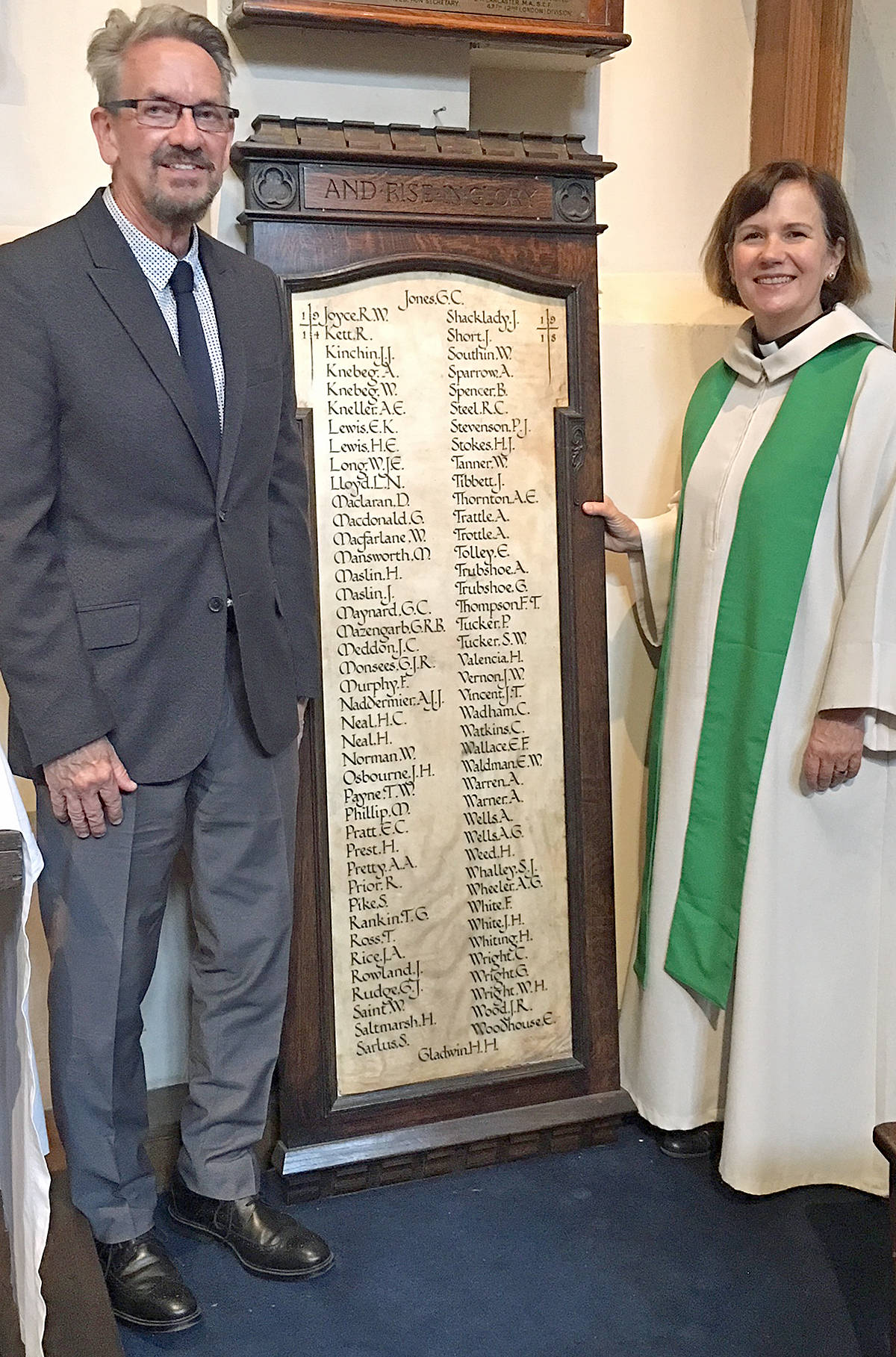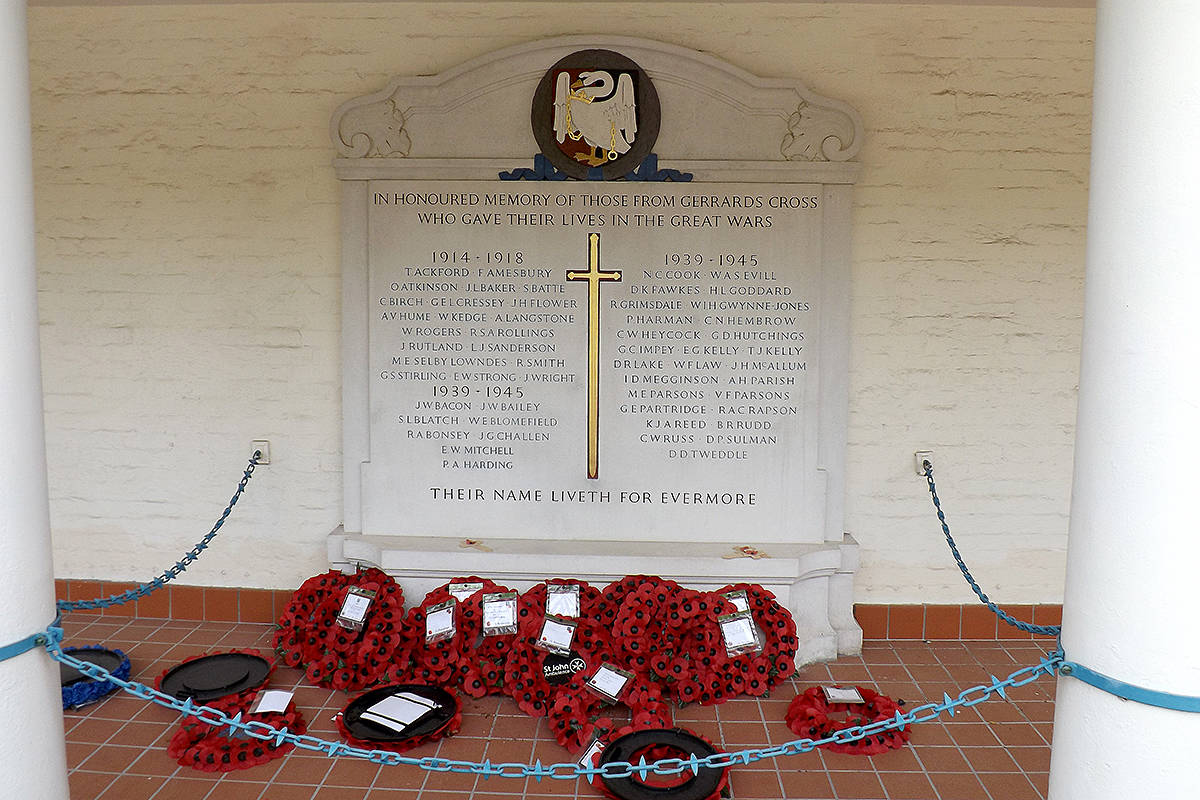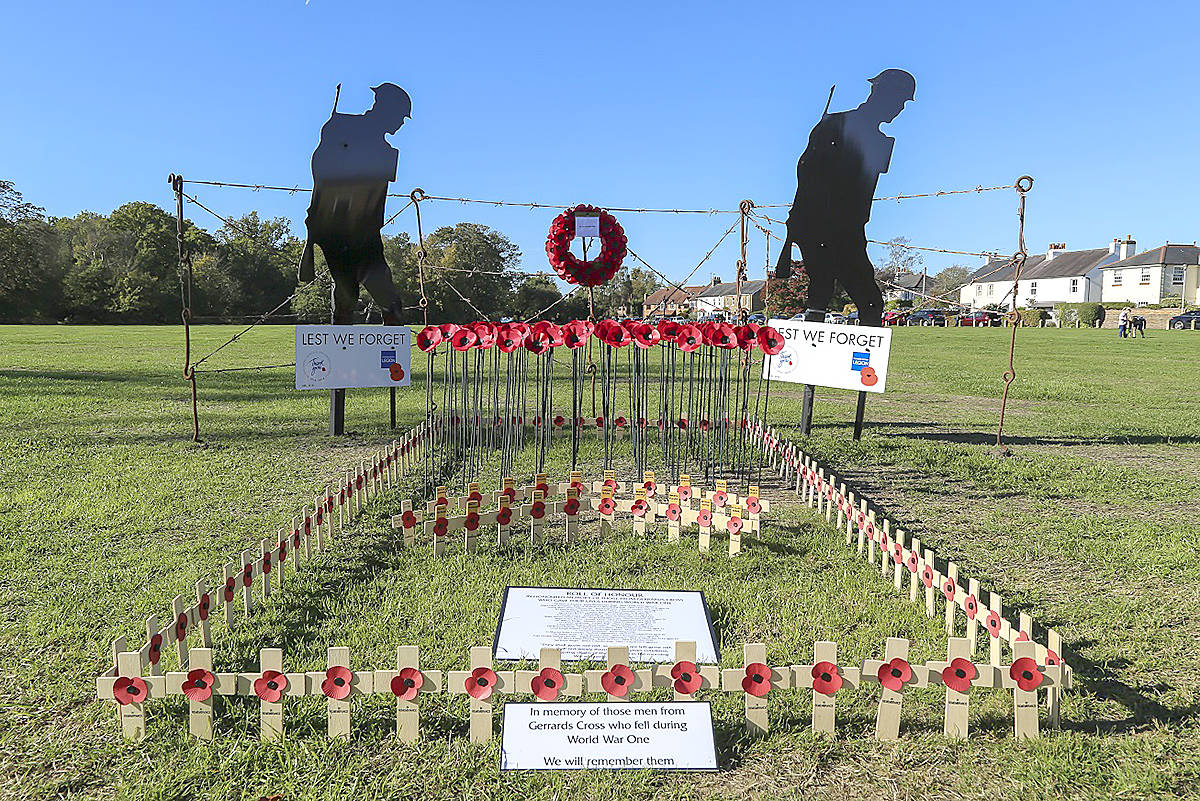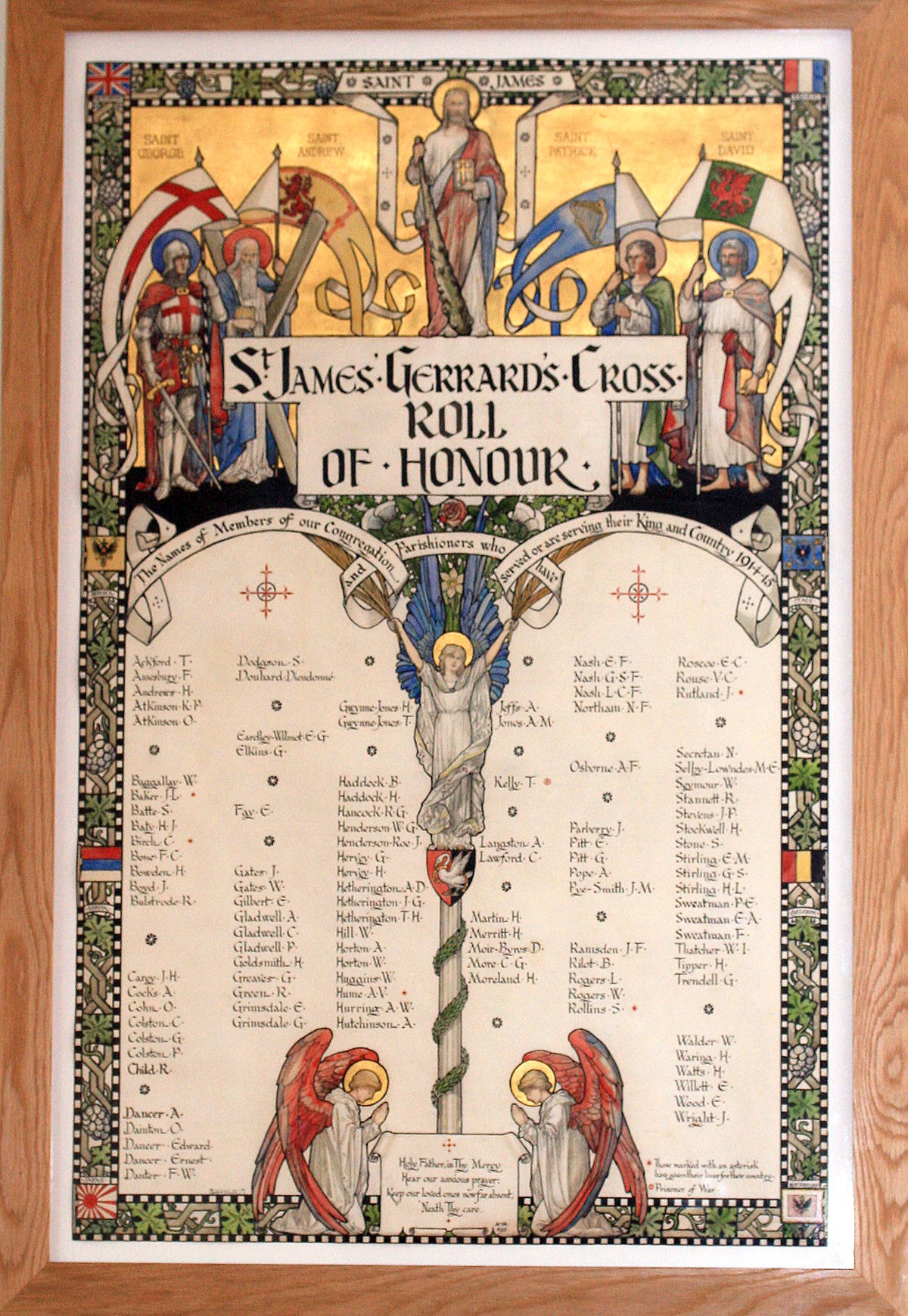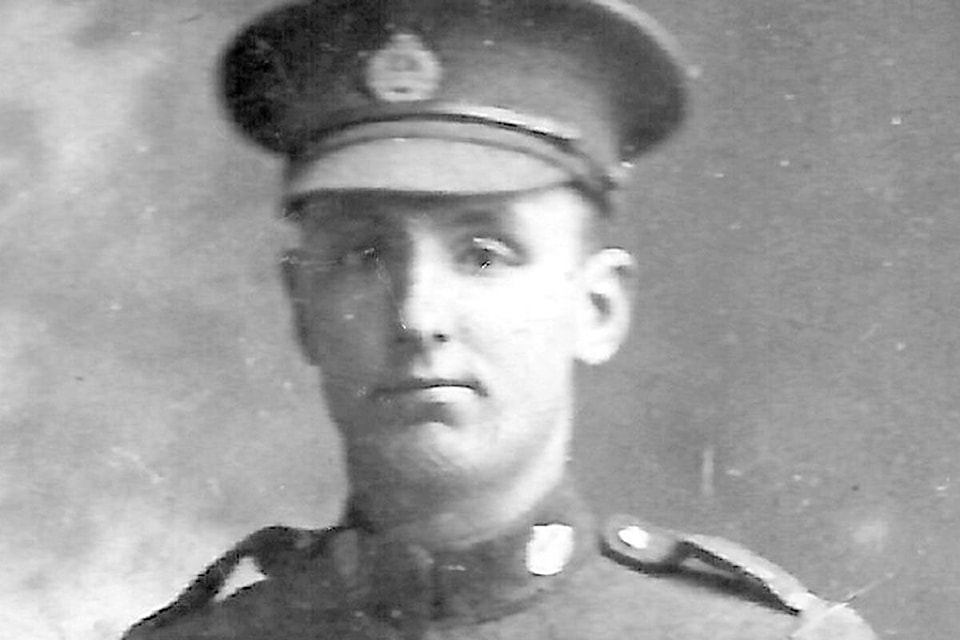by Warren Sommer/Special to the Langley Advance
A century after their deaths in battle during what was then known as the Great War, Langley historian and author Warren Sommer recounts how two Langley soldiers are being remembered on both sides of the Atlantic.
They were both young: recent immigrants from England seeking new lives in a land of fresh, unlimited opportunity.
Their lives were going well and their futures seemed secure. Fate, however, would dictate otherwise.
Born in the East End of London in 1888, Alfred William Trattle was only 21 years old when he and his wife Emma Wright immigrated to Canada in 1911.
The young couple was accompanied by Emma’s parents and several of her eight younger siblings, one of whom was her 16-year-old brother Jesse.
The Wright and Trattle families settled near each other on the then-partly-forested west side of Fort Langley.
In 1911, the village was sparsely inhabited though recent immigration from Britain had given the community’s indigenous and European population a modest boost.
The majority of the settlement’s largely-English inhabitants eked out their livings on small farm acreages, the men in the family supplementing their incomes as fishermen, farm labourers, or railway workers.
Alf Trattle was no exception. Although he was born and raised in an urban environment, Alf and his wife purchased a two-acre farm property, much of it covered in bush.
With little or no income coming in from their yet undeveloped holding, Alf found work on Mufford Brothers’ farm, in nearby Milner, while Emma kept house for George and Ellen Sellers, two of the village’s more prominent residents.
Emma’s parents and her siblings also put down roots. By the summer of 1914 Emma’s brother Jesse was a strapping 19-year-old who supplemented his work as a fisherman with that of a seasonal farm labourer.
Having escaped the social and economic constraints of early-20th-century England, the Trattles seem to have enjoyed a happy, if humble existence.
With two young sons: Alf Jr., then aged three, and Bill, who had only just been born, the couple had every reason to feel positive about their future.
Their optimism was not to last.
In June of that year the assassination of the heir to the Austro-Hungarian throne thrust Europe to war. As a loyal dominion within the British Empire, Canada entered the conflict at the mother country’s side. Canadians enlisted by the thousands, intent on defending the Empire’s freedom and honour.
Like many recent immigrants from England, Alf Trattle and Jesse Wright were doubtless torn between their duty to their country and their responsibility to their families.
Unmarried and perhaps impelled both by patriotism and a quest for adventure, Jesse enlisted in the 104th Westminster Fusiliers within days of war being declared.
By September Jesse was training with the First Canadian Contingent in Valcartier, Que. Ultimately assigned to the 7th Canadian Infantry Battalion, Jesse arrived in France in February 1915, just in time to participate in the Second Battle of Ypres, where the Canadians were subjected to the first poisonous gas attack in history.
Following his brother-in-law’s example, Alf Trattle enlisted in New Westminster’s 131st Battalion in March 1916.
After training in New Westminster and Vernon, he embarked from Halifax in early November and arrived at the front in mid-December.
Alf’s arrival in France coincided with the Canadians’ preparation for their now-famous assault on Vimy Ridge.
The next three months would have been both exciting and unnerving, as Alf and his chums watched the Canadian engineers and railway troops extending the roads and light railways required to move troops and supplies.
The Canadians’ signaller and labour battalions were no less active as they buried telephone and telegraph lines and improved or extended the tunnels through which the attacking troops would pass when the carefully-planned battle began.
Early on the morning of April 7, 1917 the Canadian artillery let loose with every gun at its command.
Explosive-laden mines previously planted under enemy lines were simultaneously blown, destroying many of the enemy’s defences while causing confusion among those who survived the blasts.
The Canadian infantry then went “over the top” in waves, capturing strong point after strong point.
By that evening most of the Canadians’ objectives had been captured, placing the highly strategic Vimy Ridge in Allied hands for the first time since the war began.
The Canadian achievement elicited rejoicing throughout the Empire. But, as British Columbians picked up their newspapers and read that their countrymen had thrust a “wedge into the last defences of tyranny,” many must have wondered how their loved ones overseas had fared in the battle.
For thousands of families, the news would not be good. Victory had come at a high cost.
Some 3,598 Canadians had been killed during the battle. A further 7,004 lay wounded. Hundreds of these would die of their injuries in the days and weeks that followed.
Nor did the capture of the ridge end hostilities in the area. Heavy artillery fire continued as the Canadians attempted to consolidate their positions and the Germans attempted to regain lost ground.
Promoted to the rank of sergeant at the end of March, Jesse was killed in action two weeks after the taking of Vimy Ridge.
His family’s grief would soon redouble. A few weeks after learning of Jesse’s death, a second telegram arrived at the Trattle family’s home. The news was devastating: Jesse’s brother-in-law, Alf, was also dead; he too had been killed near Vimy.
One can only attempt to imagine the Trattle and Wright families’ grief on losing two young men within weeks of each other.
The two families were far from alone.
Fort Langley logger Brian Butler, Aldergrove teacher Fred Campbell, Murrayville student Hazy Simonds, and Fern Ridge farm boy Stanley Tyers were also among the community’s fatalities.
The war continued for another 18 months.
By the time it was over, dozens of Langley’s soldiers had fallen victim to the conflict.
Deeply moved by their community’s losses, municipal clerk Archie Payne and doctor Benjamin Marr were determined that their sacrifices not be forgotten.
Under their leadership roads were renamed in honour of the fallen.
Trees were planted at key intersections, each dedicated to the memory of an individual soldier.
No less importantly, twin granite war memorials were erected in the Fort Langley and Murrayville cemeteries. Each of the monuments bears the names of soldiers from Langley then known to have perished during the war, Jesse and Alf among them.
The two Fort Langley men were also remembered in their native England. Alf’s name appears on a memorial in Bow Church, a 700-year-old building located not far from where the Trattle family lived in London.
In 1922, Jesse’s sacrifice was commemorated on a tablet installed at the newly-built Memorial Building in Gerrards Cross, the town in rural Buckinghamshire where the Wright family had lived prior to coming to Langley.
Jesse’s sacrifice was also commemorated on a roll of honour located in the town’s parish church.
A century after the war’s conclusion, the memorialization of the dead continues in both Britain and Canada.
The scale of these efforts has been nothing short of remarkable.
Many Advance readers will be familiar with the dramatic Blood Swept Lands and Seas of Red installation at the Tower of London in 2014. Cascading over the Tower’s walls and filling its surrounding moat, the display featured 888,246 red ceramic poppies, each one representing the sacrifice of an individual British, dominion, or colonial serviceman who had perished during the war.
Smaller in scale, but no less moving, the There But Not There initiative that began in Britain has now spread to Canada.
Featuring public installations of life-size silhouettes of Great War soldiers, the project commemorates the fallen while raising funds to help today’s British and Commonwealth veterans to deal with the mental and physical wounds of their service.
Local communities on both sides of the Atlantic have also been active in remembering the conflict’s centennial.
The parish of Bow Church recently restored its war memorials and published a book about the men listed on them. The church’s website now devotes several pages to the parish’s wartime dead, with Alf Trattle receiving a page of his own.
In Gerrards Cross, the wartime sacrifice of Jesse Wright was recently honoured by the British legion. Located on the town’s West Common, the organization’s “Field of Honour” features a series of ceramic poppies and wooden crosses, each crafted in memory of a single fatality, the entire installation being flanked by a barbed wire entanglement and a pair of life-sized silhouettes of Great War soldiers. Community members have also created a poster in Jesse’s memory.
A number of British Columbian communities have also been moved by the Great War centennial, Langley being no exception.
The Langley Centennial Museum’s Sacrifice and Sorrow exhibition, which opened on the 100th anniversary of the Battle of Vimy Ridge, attracted visitors in their thousands.
A series of street banners, each featuring a portrait of one of the community’s Great War soldiers, accompanied the exhibit. Intended for re-use, the banners will be re-installed in Fort Langley each November.
Discussions between the Township’s parks department and the Fort Langley Remembrance Day committee will soon result in the installation of interpretive signs near the Fort Langley and Murrayville war memorials.
Each will include images of men named on the monuments, with Fort Langley’s incorporating portraits of both Alf and Jesse.
The Great War centennial, and Alf and Jesse’s stories in particular, have also inspired individual community members.
On learning that Fort Langley’s memorial trees were dead or dying and about to be cut down (the dead trees were subsequently replaced), Langley Fine Arts School teacher Robyn Lorensen began to research the men these trees commemorated.
Recognizing that the two men had lived not far from the school and had routinely walked the same streets that her students traversed every day, Lorensen decided to honour the two men in song.
“It intrigued me when I learned that Jesse Wright and Alf Trattle were brothers-in-law. It suddenly went off in my head: ‘Trattle and Wright, Trattle and Wright.’ I must write a song about that!”
Lorensen followed through on her idea and the song she composed was sung by her students at the school’s Remembrance Day assemblies in November 2017 (Story, page A13).
Walter Scotton, one of Lorensen’s colleagues at the school, was no less moved on seeing the memorial trees come down.
In Scotton’s eyes, “The trees were sacred because they were planted for community members whose life was sacrificed in the Great War.”
Feeling that some of the wood should be used to perpetuate the memory of the men the trees commemorated, Scotton rescued several slabs from the Trattle tree and directed them to his father, John, an accomplished wood turner.
John, whose grandfather had served in both the South African and First World Wars, and whose father and uncles had served in the Second World War, was equally enthusiastic.
In the months that followed, John crafted a series of beautifully turned wood vessels. One of these was a communion cup that the Scottons readily agreed to offer to Bow Church.
The offer was gratefully accepted, and as I was about to leave for a vacation in England, I was able to present the cup to the church’s congregation at their Aug. 19 service.
The church’s assistant priest designed the service around the theme of sacrifice and included appropriate hymns and readings.
I was asked to speak about Trattle’s connection to the Bow and Fort Langley communities, as well as about the cup’s making.
The vessel was used for communion later in the service and now takes its place with the treasured silver vessels owned by the parish.
Alf and Jesse’s stories do not end there. Alf was buried in what is now a Commonwealth War Graves Commission cemetery near Vimy.
Jesse, however, has no known grave, all traces of his burial having been destroyed by repeated artillery fire. His memory – and those of 11,284 other Canadians with no known graves – is perpetuated in inscriptions on the Canadian Memorial at Vimy.
Remarkably, one of Jesse’s great-nephews recently discovered a reference to Jesse’s grave coordinates in a regimental archive.
A century after his death, the Fort Langley fisherman may yet possess a marked grave of his own.
The 100th anniversary of the end of the First World War reminds us of the sacrifices made by so many young men all those years ago.
The stories of Alf Trattle and Jesse Wright are tangible evidence of how the phrases often uttered on Remembrance Day, “Lest We Forget” and “We will remember them,” are still being honoured and put into practice.
.
– Contributor Warren Sommer is the author of Canucks in Khaki: Langley, the Lower Mainland, and the Great War of 1914 to 1918, available at the Langley Centennial Museum or by contacting bsommer@telus.net
.
READ MORE: Langley legion members help ensure City ceremony happens
READ MORE: Fort Langley ceremony honours fallen on Nov. 11
READ MORE: Murrayville better prepared to host second Remembrance Day ceremony
READ MORE: Aldergrove will pause to Remember
